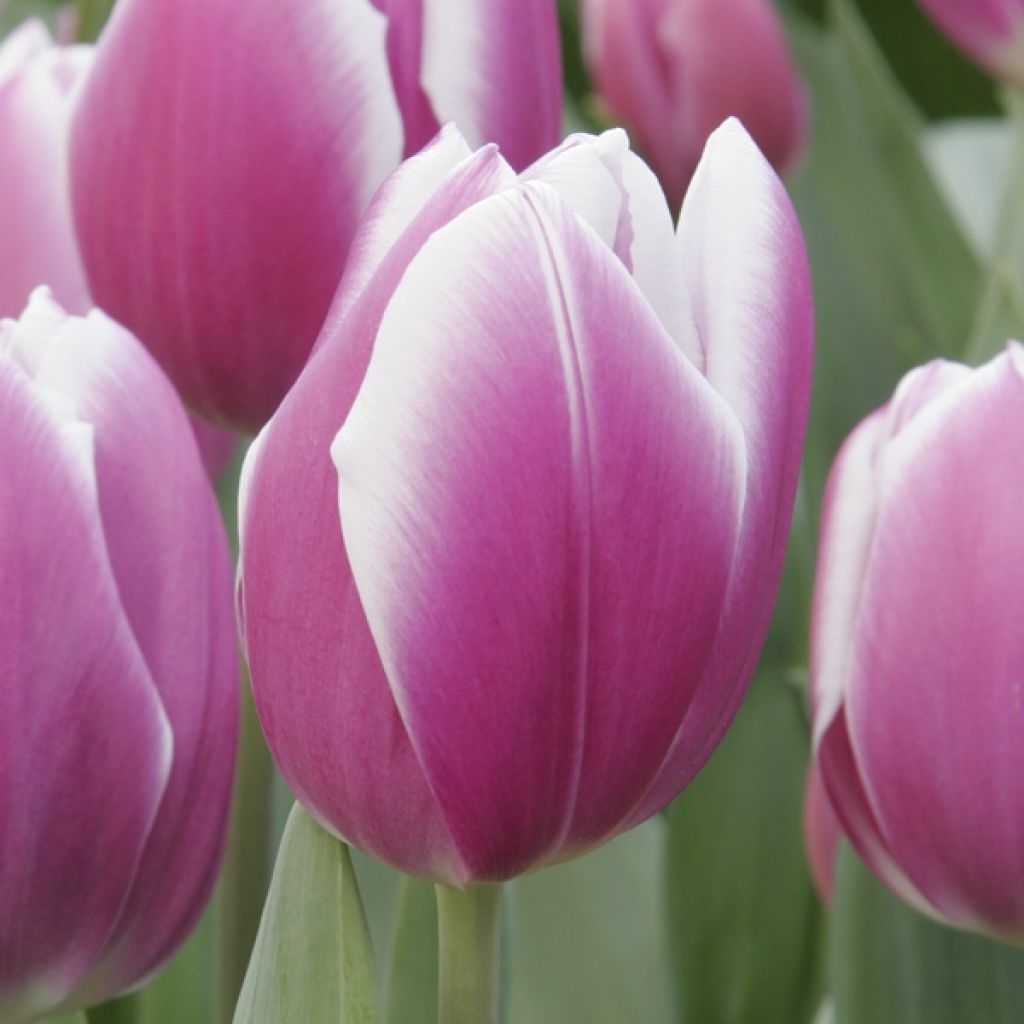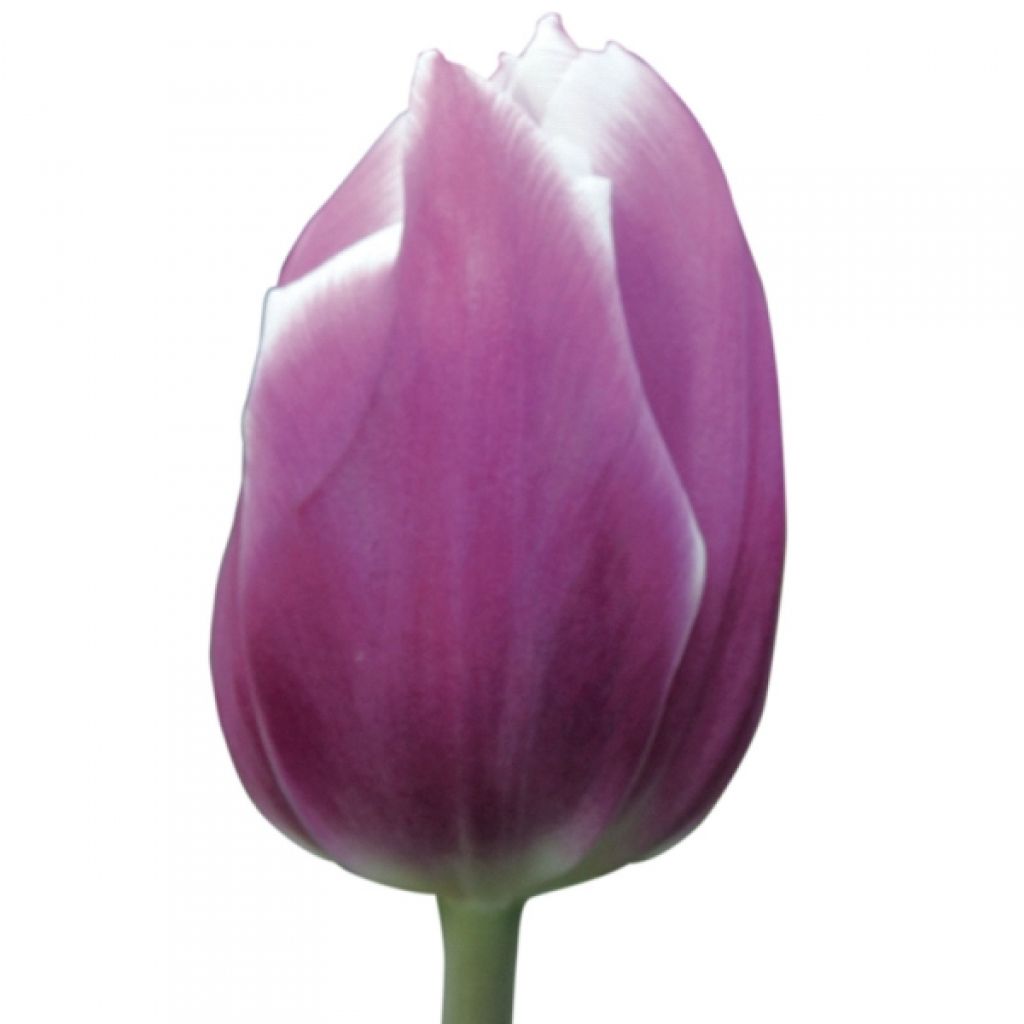

Tulipe Triomphe Synaeda Blue


Tulipe Triomphe Synaeda Blue
Tulipa Synaeda Blue - Triumph Tulip
Tulipa Triumph Synaeda Blue
Triumph Tulip
This plant carries a 6 months recovery warranty
More information
We guarantee the quality of our plants for a full growing cycle, and will replace at our expense any plant that fails to recover under normal climatic and planting conditions.
From €5.90 for pickup delivery and €6.90 for home delivery
Express home delivery from €8.90.

Does this plant fit my garden?
Set up your Plantfit profile →
Description
The Synaeda 'Blue Triumph' Tulip is irresistible. It's hard not to succumb on a sunny day to its large flower with a corolla of indescribable mauve-pink that seems speckled. Carried by a sturdy stem, each flower is a large cup of incandescent pink-lilac colour with a violet-purple centre, composed of beautifully iridescent petals bordered in very pale pink to sparkling white. This variety is one of the most spectacular and brightest, especially when combined in beds and borders with white tulips and muscari. Its lightly scented flowers are perfect for bouquets.
The 'Synaeda Blue' Tulip, introduced in 1996, belongs to the Lily family. Of horticultural origin, it is currently classified in Group 3 of 'Triumph' tulips, which are characterised by their narrow cup-shaped flowers. Perched on strong, tall stems of 40 cm (16in) above the broadly lanceolate leaves, the elegant flowers, with their narrow cup shape, measure 4 to 6 cm (2in) in diameter and have six "petals" (more precisely tepals) of thick texture, where small coloured spots can be seen. Each petal, overall mauve-pink, is widely bordered in very pale pink that becomes white as the hours go by. The flowering takes place in April - May, in the heart of the tulip season.
The 'Synaeda Blue' Triumph Tulip finds its place in large beds and borders, planted alone or in the company of blue flowers (forget-me-nots, bellflowers, muscari) or white flowers (Tulips 'Sapporo', 'Maureen'). The brilliance and delicacy of its colour allows for numerous associations with perennials or other tulips. A beautiful white variety (Tulip 'Blanche Neige', or 'White Dream') will also accompany it elegantly in a pot or border. Also pair it with daffodils, jonquils, hyacinths, Corsican hellebores, and euphorbias for stunning scenes. This tulip also beautifies balconies and terraces very well. It is also ideal for creating elegant bouquets. In a vase, use very little water, just a little at the bottom is enough! Furthermore, if your tulips open too quickly, you can add two to three ice cubes to the vase each day.
Report an error about the product description
Plant habit
Flowering
Foliage
Botanical data
Tulipa
Triumph
Synaeda Blue
Liliaceae
Triumph Tulip
Cultivar or hybrid
Planting and care
Plant the bulbs in autumn, from September to December, at a depth of 15 cm (6in), spacing them 10 cm (4in) apart. The planting should be done in ordinary soil, slightly acidic, neutral, or slightly alkaline, loose, well-worked, and most importantly, well-draining. Tulips are sensitive to excess moisture in summer, which corresponds to their resting period. Never add undecomposed manure or compost to the planting soil, as this could cause the bulbs to rot. The 'Synaeda Blue' tulip will thrive in cool, even heavy and clayey soil throughout the year, as long as it is dry in summer. Plant it in a sunny or semi-shaded location. Once flowering is over, it is advisable to remove the fruits to avoid exhausting the plant.
Planting period
Intended location
Care
-
, onOrder confirmed
Reply from on Promesse de fleurs
Haven't found what you were looking for?
Hardiness is the lowest winter temperature a plant can endure without suffering serious damage or even dying. However, hardiness is affected by location (a sheltered area, such as a patio), protection (winter cover) and soil type (hardiness is improved by well-drained soil).

Photo Sharing Terms & Conditions
In order to encourage gardeners to interact and share their experiences, Promesse de fleurs offers various media enabling content to be uploaded onto its Site - in particular via the ‘Photo sharing’ module.
The User agrees to refrain from:
- Posting any content that is illegal, prejudicial, insulting, racist, inciteful to hatred, revisionist, contrary to public decency, that infringes on privacy or on the privacy rights of third parties, in particular the publicity rights of persons and goods, intellectual property rights, or the right to privacy.
- Submitting content on behalf of a third party;
- Impersonate the identity of a third party and/or publish any personal information about a third party;
In general, the User undertakes to refrain from any unethical behaviour.
All Content (in particular text, comments, files, images, photos, videos, creative works, etc.), which may be subject to property or intellectual property rights, image or other private rights, shall remain the property of the User, subject to the limited rights granted by the terms of the licence granted by Promesse de fleurs as stated below. Users are at liberty to publish or not to publish such Content on the Site, notably via the ‘Photo Sharing’ facility, and accept that this Content shall be made public and freely accessible, notably on the Internet.
Users further acknowledge, undertake to have ,and guarantee that they hold all necessary rights and permissions to publish such material on the Site, in particular with regard to the legislation in force pertaining to any privacy, property, intellectual property, image, or contractual rights, or rights of any other nature. By publishing such Content on the Site, Users acknowledge accepting full liability as publishers of the Content within the meaning of the law, and grant Promesse de fleurs, free of charge, an inclusive, worldwide licence for the said Content for the entire duration of its publication, including all reproduction, representation, up/downloading, displaying, performing, transmission, and storage rights.
Users also grant permission for their name to be linked to the Content and accept that this link may not always be made available.
By engaging in posting material, Users consent to their Content becoming automatically accessible on the Internet, in particular on other sites and/or blogs and/or web pages of the Promesse de fleurs site, including in particular social pages and the Promesse de fleurs catalogue.
Users may secure the removal of entrusted content free of charge by issuing a simple request via our contact form.
The flowering period indicated on our website applies to countries and regions located in USDA zone 8 (France, the United Kingdom, Ireland, the Netherlands, etc.)
It will vary according to where you live:
- In zones 9 to 10 (Italy, Spain, Greece, etc.), flowering will occur about 2 to 4 weeks earlier.
- In zones 6 to 7 (Germany, Poland, Slovenia, and lower mountainous regions), flowering will be delayed by 2 to 3 weeks.
- In zone 5 (Central Europe, Scandinavia), blooming will be delayed by 3 to 5 weeks.
In temperate climates, pruning of spring-flowering shrubs (forsythia, spireas, etc.) should be done just after flowering.
Pruning of summer-flowering shrubs (Indian Lilac, Perovskia, etc.) can be done in winter or spring.
In cold regions as well as with frost-sensitive plants, avoid pruning too early when severe frosts may still occur.
The planting period indicated on our website applies to countries and regions located in USDA zone 8 (France, United Kingdom, Ireland, Netherlands).
It will vary according to where you live:
- In Mediterranean zones (Marseille, Madrid, Milan, etc.), autumn and winter are the best planting periods.
- In continental zones (Strasbourg, Munich, Vienna, etc.), delay planting by 2 to 3 weeks in spring and bring it forward by 2 to 4 weeks in autumn.
- In mountainous regions (the Alps, Pyrenees, Carpathians, etc.), it is best to plant in late spring (May-June) or late summer (August-September).
The harvesting period indicated on our website applies to countries and regions in USDA zone 8 (France, England, Ireland, the Netherlands).
In colder areas (Scandinavia, Poland, Austria...) fruit and vegetable harvests are likely to be delayed by 3-4 weeks.
In warmer areas (Italy, Spain, Greece, etc.), harvesting will probably take place earlier, depending on weather conditions.
The sowing periods indicated on our website apply to countries and regions within USDA Zone 8 (France, UK, Ireland, Netherlands).
In colder areas (Scandinavia, Poland, Austria...), delay any outdoor sowing by 3-4 weeks, or sow under glass.
In warmer climes (Italy, Spain, Greece, etc.), bring outdoor sowing forward by a few weeks.



































